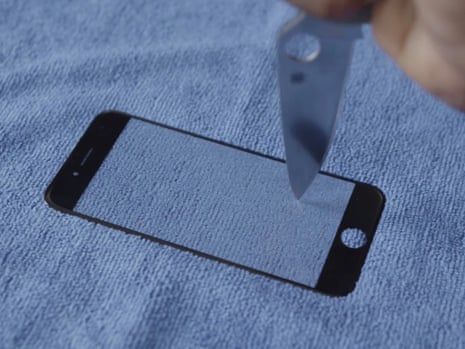Apple discussed forming screens from super-hard “sapphire glass” 18 months ago with experts in the field, making a sapphire-fronted iPhone 6 highly likely, the Guardian has established.
A video that apparently shows a 4.7in sapphire screen being bent under a foot and resisting attack from a knife and keys "could well be" legitimate, according to Professor Neil Alford of the department of materials at Imperial College, London.
“I think Apple have been quite cunning,” Alford told the Guardian. “What I think they’ve done is make a screen out of sapphire, which is incredibly scratch resistant, incredibly hard and has a high elastic modulus – meaning it’s very stiff.”
Apple already uses sapphire crystal for its camera lenses and the cover of the iPhone 5S's Touch ID fingerprint sensor, but the super-hard material - the third hardest known - could make excellent screens that are much more scratch resistant than traditional glass and potentially even Corning’s Gorilla Glass, which covers the majority of smartphone and tablet screens.
But it would be a demanding move. A 4.7in screen like that shown in the video has an area of about 9.5 square inches. Apple sells tens of millions of phones every quarter - so that just 10m 4.7in sapphire-screened phones would require 6 hectares, or 61,290 square metres, of the glass.
'Apple folk coming to speak to me about 18 months ago'
However Apple has a multi-year joint venture in the US with GT Advanced to build plants and furnaces able to produce sapphire in industrial quantities for a "critical component" that it said in trade documents would be shipped abroad for assembly. That could refer to the touch sensors - or to screens.
Sapphire crystals are made from aluminium oxide powder, rather as standard glass is made from silicon dioxide. Once heated and cooled, it can be cut and formed into glass-like layers – known as sapphire glass. The optically transparent material has long been used for camera lenses as well as the screens of high-end watches because of its combination of scratch resistance and high transparency.
“I remember the Apple folk coming to speak to me about 18 months ago to discuss sapphire screens,” remarked Alford. "They’ve obviously been busy since then, working with a sapphire manufacturer."
Alford explained that sapphire has been used in large quantities in electronic components for years.
'Not surprising'
“It’s not a surprising thing to do, but it’s quite a large area they’re producing and that’s really quite a challenge. I’m pretty impressed with that, actually,” said Alford.
Alford was commenting on a video of a part claimed to be a sapphire screen for the expected iPhone 6 from a factory in China. The video shows Marques Brownlee stabbing the screen with a knife, bending it under a shoe and trying - and failing – to mark it with keys.
Brownlee, who was sent the part by blogger Sonny Dickson, told the Guardian that he was sure the screen was “100% an Apple part”. Though he had his doubts at first - and wondered if the screen was just standard Gorilla Glass - after testing it, “I’m convinced the display is sapphire.”
Alford concurs: “In my opinion the screen being shown off in the video could well be a sapphire screen. If you make sapphire thin enough, and it’s flaw free, you can bend it quite considerably because it has an enormous strength.”
He added: “I think they will be doing some sort of a lamination – binding different crystal cuts of sapphire together – boosting the toughness of the material, while they may also have induced some sort of a strain in the surface of the glass – either compression or tension – which means that it has extra strength,” he said.
'Forced to use diamond slicers'
Sapphire has many advantages over glass, but has been prohibitively expensive to produce in large areas despite abundant raw materials. Creating artificial sapphire is not a problem in smaller areas for electronics and other uses, much in the same way artificial diamonds are used in manufacturing.
Alford explained that compared to glass, sapphire would be harder, tougher making it more resistant to cracking or shattering, and optically clear.
“The big issue is how you slice it and polish it because of the hardness of sapphire crystals,” said Alford. “It’s quite problematic; they’ll be forced to use diamond slicers to cut the sapphire for instance.”
“If they can manage the costs, I don’t think there are any downsides to using sapphire at all. It’s a great idea,” quipped Alford.
Apple and its sapphire manufacturing partner are likely to have patented manufacturing processes for creating the sapphire screens meaning that other manufactures like Corning, producer of Gorilla Glass, might not be able to replicate the sapphire screens.

Comments (…)
Sign in or create your Guardian account to join the discussion